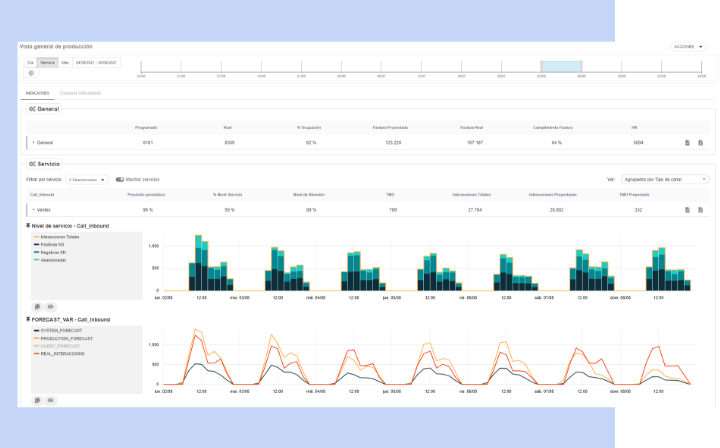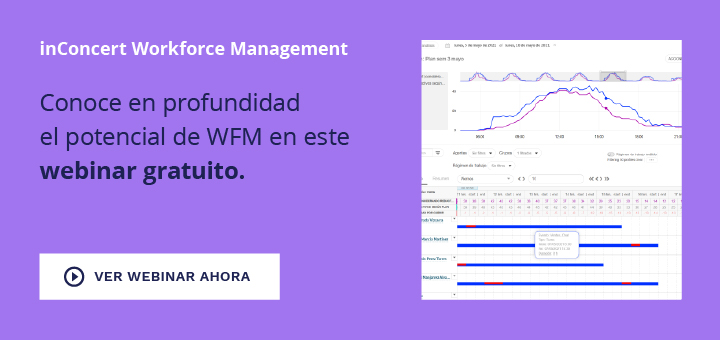Real-time analysts are the gatekeepers of the operation. The analyst’s mission is to monitor compliance with the shift schedule and the main indicators. From this mission, some elementary functions are derived that include activities such as raising alerts, generating and updating periodic reports, and executing actions to control the results of the levels agreed with the client at the interval and day level.
Despite being the most “basic” level of the Workforce Management (WFM) “career path”, this role is, in my humble opinion, one of the most important and complex. Real-time analysts (RTAs) are aware of every event that happens during the day, they are present before the operation starts activities and after the end of the day; and before agents and operations supervisors they are the first point of contact with the Workforce team.
For this reason, I share with you the five most important things a real-time analyst should know to be excellent at their job.
Top 5 things a real-time analyst should know
1) Management of the KPIs with which the operation is measured.
KPIs, which stands for Key Performance Indicator, are standard ways of measuring the productivity and effectiveness of a project. In contact centers, different indicators are used depending on the type of campaign being managed, the type of invoice and other factors. Among the KPIs most commonly used in Workforce are Service Level, Abandonment Level, Occupancy Rate, Invoice Fulfillment and number of interactions on hold, among others.
The measurement of the indicators, as well as the objectives of these, vary from one client to another. It is vital that analysts know the formulas and variables that make up the calculation, as well as the actions that can affect the indicator results positively or negatively, in order to keep the result on target. Knowledge of the calculations and how one metric impacts another allows the analyst to explain the key causes of non-compliance of key indicators. This knowledge also allows him/her to suggest options for readjusting the course of the execution plan.
One of the most important functions, apart from keeping the reports that allow the KPIs to be tracked up to date, is the feeding of the daily log. The log is a summary of the results of the indicators and the main reasons for compliance or non-compliance, and is especially helpful in daily follow-ups with clients and the operations team.
2) Financial impact of real time decisions
As in any company, decisions made at different hierarchical levels are driven by profitability and economic sustainability. Contact centers are no exception, and real-time monitoring has a gigantic impact on the profitability of a customer/account/campaign.
The results of service indicators can lead to invoice penalties, and in very extreme cases, to customer churn. Monitoring indicators at the interval level – which is the job of the RTA – is equivalent to monitoring results at the day level; and days with on-target indicators translate to monthly compliance.
But it is not only service level indicators that cause loss of profitability. The inadequate or excessive use of unpaid (or non-productive) assistants greatly impacts the economic sustainability of an account. Fixed personnel costs, representing a large portion of a contact center’s total operating costs, must be controlled, and any unproductivity must be corrected without delay.
The analyst is not only an advisor, but is the human face of WFM. Customers (i.e., contact center accounts or campaigns) do not only have corporate news (such as the volume of interactions or creation of a new campaign). The real-time analyst knows about family situations, end-of-study seasons, personal situations, etc. Each suggestion regarding these developments has pros and cons, and it is the task of each analyst to make the best possible case for each option so that the operation leaders can make better business decisions.
3) How to execute a shift schedule
Generally, the real-time analyst team is not directly in charge of generating the agents’ shift grids. However, the RTAs are in charge of monitoring that the actual connection of the agents is faithful to the schedule. They are also in charge of making/requesting immediate changes to adapt to unforeseen changes in the volume of interactions. Many times, the analyst must also “educate” operations and agents on the best processes and times to include activities in the schedules, or when it is convenient to establish breaks and corporate culture spaces without affecting coverage.
The scheduling and its execution generates valuable information that feeds other internal processes of WFM, and other areas of the contact center. Analyzing indicators such as absenteeism or staffing compliance (comparative of how many agents are required from the plan, how many are scheduled and how many are actually connected per interval), percentage of productive assistants, percentage of non-productive assistants, disconnections, movement of agents to support other services in real time; can be decisive for the fulfillment of service level agreements, and, consequently, the fulfillment of the estimated bill.

4) Scaling matrix
Surely those of us who have been in the position of RTA have found ourselves in a situation that leads us to ask ourselves questions such as the following: what to do if absenteeism is higher than expected? What to do if the TMO remains above the target for several consecutive intervals? Who do I ask for support? When and by what means should I ask for support to restore an indicator within the threshold?
These and other scenarios should be written down in an “escalation matrix,” which is like the ATR bible. This matrix should be the result of identifying the operation’s potential risk scenarios, how they affect the indicators, what to do and who to alert. Generally, the matrix has been defined by WFM leadership and contact center operations.
5) Seeing beyond the obvious
Finally, the last thing that every real-time analyst must keep in mind is to anticipate the following intervals. Knowledge of the indicators and the escalation matrix is critical, but it will be ineffective if it is not complemented by analysis of the current situation and forecasting what will happen in the immediate future (the close of the current interval, the next few hours). It is also important to communicate these impacts to the short and medium-term planning team to mitigate possible impacts in the coming days, weeks, or at the close of the month.
To illustrate, I will use a real-life scenario: an unscheduled outage of all the agents’ computers. At the moment everything goes to chaos, agents lost all the interactions they were in, and service levels start to drop. In less than 15 minutes the technology team resolves the issue and gradually all agents are back online.
The RTA has had 15 minutes to prepare the following intervals that should compensate for the service level drop. The first action to be taken is to reschedule all non-productive activities of the following intervals, and ensure that all agents, and staff if necessary, are connected.
If an RTA does not have this vision, nor the necessary tools to ensure follow-up, this case could represent not just one, but several lost intervals of the day.




